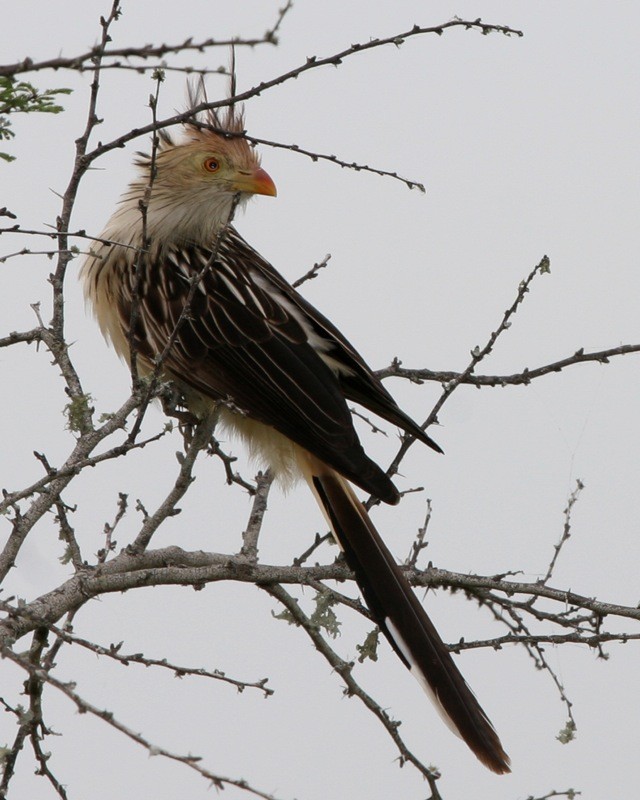Guira Cuckoo
A species of Guira Cuckoo Scientific name : Guira guira Genus : Guira Cuckoo
Guira Cuckoo, A species of Guira Cuckoo
Botanical name: Guira guira
Genus: Guira Cuckoo
Content
Description General Info
 Photo By Lip Kee Yap , used under CC-BY-SA-2.0 /Cropped and compressed from original
Photo By Lip Kee Yap , used under CC-BY-SA-2.0 /Cropped and compressed from original Description
It is a rather scruffy-looking bird, with a total length of approximately 34 cm (13 in). The sexes are very similar in appearance, except that the female is slightly larger than the male. Juveniles appear quite similar to adults. The species has dark brown upperparts streaked with white, and whitish-buff throat, breast, underparts and rump. The tail is relatively long and broad, dark brown in color with a white-tip, and the legs are dark gray. The eyes and beak are yellow to orange, with a thin ring of featherless yellow skin around the eye (this commonly fades in captivity). There is a prominent orange-rufous crest. Like other members of the subfamily Crotophaginae, the guira cuckoo gives off a strong, pungent odour. 
Size
36 cm
Life Expectancy
8-10 years
Nest Placement
Tree
Feeding Habits
Guira Cuckoo consumes a varied diet, including insects, frogs, lizards, and small mammals. It forages alone or in groups, often during the day, showing a particular taste for insects like grasshoppers and cicadas. Guira Cuckoo also feeds on eggs and nestlings, displaying opportunistic and adaptable feeding behaviors.
Habitat
The guira Cuckoo predominantly occupies a variety of open and semi-open landscapes. Its habitat includes second-growth scrublands, savannas with scattered trees and shrubs, as well as scrub woodlands. Additionally, it is well-adapted to living in grassy pampas, agricultural pastures, and coastal dune areas. These birds are known to form communal roosts, often seen huddling together for warmth. Their altitude range extends from sea level to elevations exceeding 1200 meters, demonstrating a wide tolerance for different habitat altitudes.
Dite type
Omnivorous
General Info
Feeding Habits
Bird food type
Behavior
The guira cuckoo is a bird of open habitats such as pastures and wetlands, and its range has expanded significantly due to deforestation. Within its distribution, it is commonly seen in suburban parks and gardens. Like the related squirrel cuckoo, the guira cuckoo is not a particularly adept flier, and usually flies only for short distances. It is often seen gliding or hopping from one perch to another while vocalizating loudly. The bird's call is unmistakable for being long and shrill, something between a long whistle and a wailing. Although it is primarily an arboreal bird, it is often seen foraging on the ground, sometimes alone but often in flocks of up to 18 individuals. It is sometimes seen with other birds whose behaviour is similar, such as the smooth-billed ani. Unlike many of the Old World cuckoos, the guira cuckoo does not practice brood parasitism or kleptoparasitism. 
Species Status
Not globally threatened.
Scientific Classification
Phylum
Chordates Class
Birds Order
Cuckoos and Relatives Family
Cuckoos Genus
Guira Cuckoo Species
Guira Cuckoo